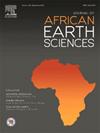Predictive modeling of orogenic gold prospectivity in the Wawa area, western Nigeria, using three most commonly-used machine learning algorithms
IF 2.2
4区 地球科学
Q2 GEOSCIENCES, MULTIDISCIPLINARY
引用次数: 0
Abstract
The unavailability of prospectivity maps for orogenic gold deposits in western Nigeria has been a significant setback in the federal government's efforts to attract mining investors. Prospectivity modeling is a potent exploration tool that allows for the segregation of large expanses of land into high and low prospectivity zones. To support the Nigerian government efforts in its diversification of the Nigerian economy towards the solid mineral sector and attract mining investments into the country, this research focused on the use of machine learning (ML) models for orogenic gold prospectivity modeling in the Wawa area, a southern extension of the gold-bearing Zuru Schist Belt of western Nigeria. A mineral system approach was applied in this study to translate the characteristics of orogenic gold deposits into nine predictor maps, accounting for heat source, fluid pathway, trapping mechanisms, and favorable host rocks needed for the formation of such deposits. The ML algorithms considered in this research were artificial neural network (ANN), support vector machine (SVM), and random forest (RF). Each of these predictive models were trained using nine predictor maps and 174 data points, consisting of known gold deposit and non-deposit points. The RF predictive model had the highest prediction efficiencies with Accuracy, AUC, and Kappa index values of 0.91, 0.96, and 0.83, respectively; the SVM model gave similar performance metrics such as accuracy (0.89), recall rate (0.88), F1 score (0.88), and Kappa index (0.77) as the ANN, but had a higher precision value (0.91) and lower AUC value (0.91) than the ANN (0.89 and 0.92, respectively). The results suggest that the three ML predictive models are suitable for orogenic gold prospectivity modeling in the study area. Further exploration for orogenic gold deposits in the Wawa area will likely be successful within the delineated high prospectivity zones.
利用三种最常用的机器学习算法对尼日利亚西部Wawa地区造山带金矿远景进行预测建模
奈及利亚西部造山带金矿的远景图无法获得,这对联邦政府吸引矿业投资者的努力造成了重大挫折。远景模型是一种强有力的勘探工具,可以将大片土地划分为高远景区和低远景区。为了支持尼日利亚政府将尼日利亚经济向固体矿产部门多元化的努力,并吸引矿业投资进入该国,本研究侧重于使用机器学习(ML)模型在Wawa地区进行造山带金矿远景建模,Wawa地区是尼日利亚西部含金Zuru片岩带的南部延伸。本文运用矿物系统方法,将造山带金矿特征转化为9张预测图,考虑了造山带金矿形成所需的热源、流体通道、圈闭机制和有利寄主岩。本研究中考虑的机器学习算法有人工神经网络(ANN)、支持向量机(SVM)和随机森林(RF)。每个预测模型使用9个预测图和174个数据点进行训练,这些数据点包括已知金矿和非金矿点。RF预测模型的准确率、AUC和Kappa指数分别为0.91、0.96和0.83,预测效率最高;SVM模型的准确率(0.89)、召回率(0.88)、F1评分(0.88)、Kappa指数(0.77)等性能指标与人工神经网络相似,但精度值(0.91)高于人工神经网络(0.89),AUC值(0.91)低于人工神经网络(0.92)。结果表明,3种ML预测模型适用于研究区造山带金矿远景模拟。在Wawa地区的高远景带内,对造山带金矿的进一步勘探将有可能取得成功。
本文章由计算机程序翻译,如有差异,请以英文原文为准。
求助全文
约1分钟内获得全文
求助全文
来源期刊

Journal of African Earth Sciences
地学-地球科学综合
CiteScore
4.70
自引率
4.30%
发文量
240
审稿时长
12 months
期刊介绍:
The Journal of African Earth Sciences sees itself as the prime geological journal for all aspects of the Earth Sciences about the African plate. Papers dealing with peripheral areas are welcome if they demonstrate a tight link with Africa.
The Journal publishes high quality, peer-reviewed scientific papers. It is devoted primarily to research papers but short communications relating to new developments of broad interest, reviews and book reviews will also be considered. Papers must have international appeal and should present work of more regional than local significance and dealing with well identified and justified scientific questions. Specialised technical papers, analytical or exploration reports must be avoided. Papers on applied geology should preferably be linked to such core disciplines and must be addressed to a more general geoscientific audience.
 求助内容:
求助内容: 应助结果提醒方式:
应助结果提醒方式:


